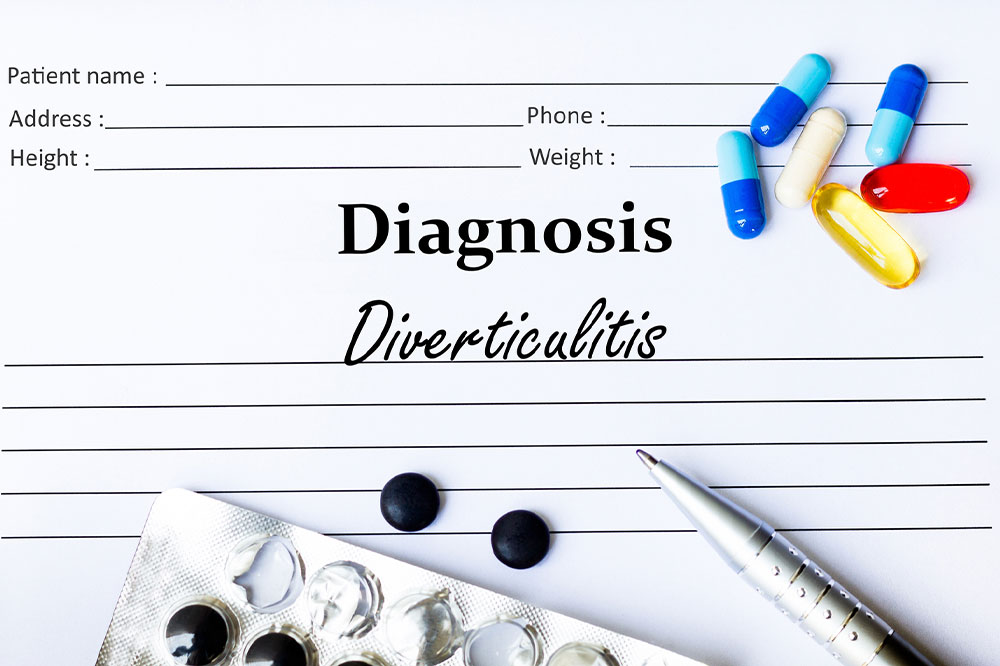Diverticulitis – Causes, Symptoms, and How to Manage the Condition
Diverticulitis is a health condition where protruding pouches develop in the lower part of the large intestine or colon. These pouches are harmless in most cases. But sometimes, they can get infected, leading to complications like bleeding, bowel obstruction, and urinary problems. The best way to deal with diverticulitis is to first learn more about it: its causes, symptoms, treatment options, and food items that can help manage or worsen the problem.
Causes
When weak areas in the colon come under excess pressure, small pouches protrude through the colon wall. These pouches are called diverticula. Over time, the pouches get inflamed and, in some cases, infected.

A few risk factors increase a person’s chances of developing the disease. These include aging, lack of physical activity or exercise, using specific treatments, and foods with animal fats.
Symptoms
Persistent pain in the lower-left side of the abdomen is the most common sign of diverticulitis. However, some experience pain on the right side. So, be observant of pain in these regions. Besides pain, one may experience nausea and vomiting and develop a fever. Abdominal tenderness and constipation are also common. In rare cases, diarrhea is a symptom.
Complications
While the pouches or diverticula protruding through the colon wall are usually not problematic, some people experience complications.
Fistula
An abnormal passageway or tunnel called a fistula can occur between the sections of the bowel or even between the bowel and other organs. Fistulas may not close on their own and may require surgery and other diverticulitis treatments to heal.
Peritonitis
When infected, an inflamed pouch can rupture into the abdominal cavity, spilling out the intestinal contents. This is called peritonitis. It is a health emergency requiring immediate attention from a health professional.
Treatment options
Diverticulitis treatment plans can vary depending on whether there are complications:
Uncomplicated diverticulitis
Doctors recommend treating the condition at home if the symptoms of diverticulitis are very mild. It includes following a liquid food plan for a couple of days. Liquid foods do not pressure the colon, making it easier for the organ to heal and recover. Patients can reintroduce solid foods once the condition starts improving.
Complicated diverticulitis
If complications have occurred, the patient usually has to be hospitalized. Doctors administer intravenous treatments to manage the condition. If the abscess bursts, they insert a tube to drain the infected liquid.
Surgery options
Besides regular diverticulitis treatment, surgery is recommended in more severe cases, such as a fistula, bowel abscess, or a puncture in the bowel wall. It may also be suitable if a person has had this illness more than once or has a weakened immune system. There are two surgery options:
Primary bowel resection
In this procedure, doctors remove the infected or diseased portions of the intestine and reconnect the healthy segments. Primary bowel resection helps restore normal bowel movement after recovery. It can either be an open surgery or minimally invasive, depending on the level of inflammation.
Colostomy
Here, doctors create an opening in the portion of the abdominal wall that is connected to the healthy part of the colon. The colon waste passes through this opening into a bag instead of the usual disposal through the rectum. This procedure can be reversed to reconnect the bowel once inflammation slows down and the patient shows signs of recovery.
Nutritional considerations
Healthy nutrition is a vital part of diverticulitis treatment. Red and processed meat, sugary items, and refined grains are some foods to avoid with diverticulitis. Instead, patients should opt for the following after consulting with a doctor:
Clear liquids
Since there is a lot of inflammation and pressure on the colon, drinking clear liquids can avoid obstruction in the passageway. Clear broths, pulp-free juices like apple or cranberry, popsicles, water, and even Jell-O are suitable.
Low-fiber foods
Individuals should avoid meals high in fiber while trying to recover, as it can put more pressure on the colon. Low-fiber starches like peeled potato, puffed rice cereal, and even corn flakes are suitable. One can bake, roast, or boil the potatoes as per their liking and add them to their plate without worry. Peaches, pears, applesauce, ripe bananas, ripe cantaloupe, and honeydew are low-fiber fruits.
Dairy
Cottage cheese, greek yogurt, milk, and cheese have no fiber. These are soft and easy to swallow and pass through the colon easily, preventing pressure in the organ.
Prevention tips
A few lifestyle adjustments help keep the condition at bay. It involves exercising regularly, at least for 30 minutes on most days. Moving the body helps with good bowel movement, relieving the pressure in the colon. Staying hydrated throughout the day is also essential, as water makes bowel movement easy. Further, individuals should avoid the foods triggering diverticulitis and anything that leads to stress.

